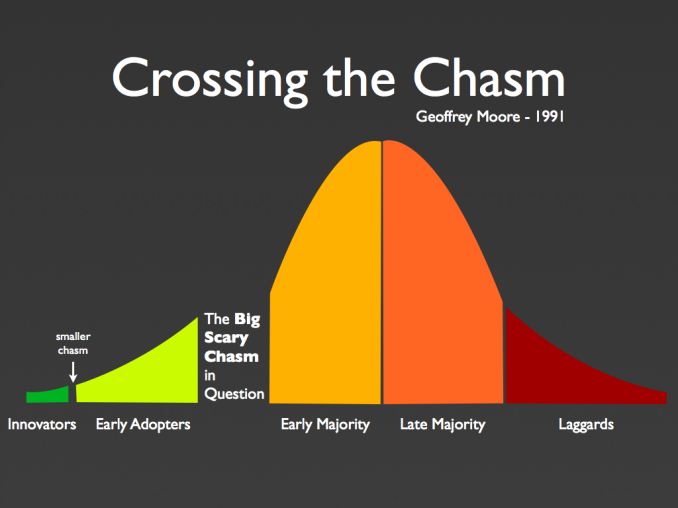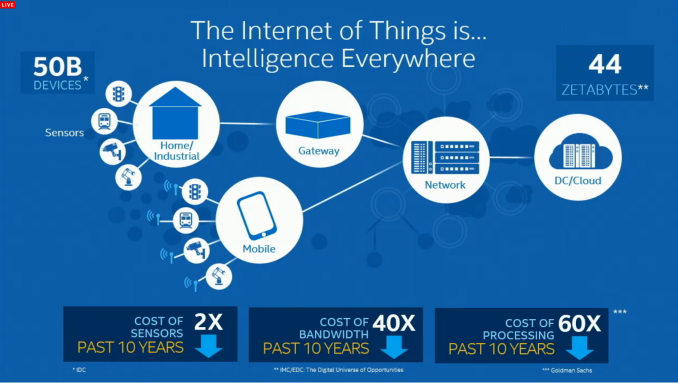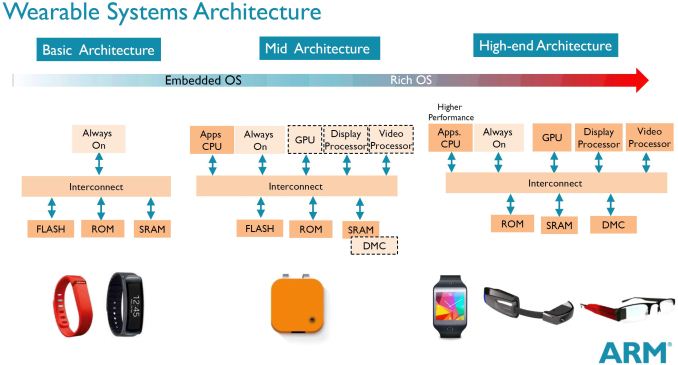Wearables: 2014 and Beyond
by Stephen Barrett on January 15, 2015 11:50 AM EST- Posted in
- Wearables
- Apple
- Microsoft
- pebble
- Android Wear
- Microsoft Band
- Fitbit

As the year 2014 has come to a close, now is a good time to inventory changes in the consumer electronics market and project those trends forward. One of the most obvious changes was that wearable technology has, by my observation, approached the brink of the adoption chasm into the early majority. In this article we will focus on the significant business and consumer factors of wearable technology, the notable introductions in 2014, as well as future AnandTech coverage.
If you are unfamiliar with ‘the chasm’, this is a reference to an acclaimed technology marketing book by Geoffrey A. Moore in 1991. As seen in the figure below, Geoffrey describes five stages of adoption.
The first, consumers described as innovators, are on the very bleeding edge. Innovators have a combination of unique interest in the subject area and abundant disposable income. There is a small chasm between this group and the next. This small chasm has killed many technologies and you could probably argue that 3D TVs died here. Next, early adopters are more like typical AnandTech readers. These consumers are technologically savvy and often the technology go-to person for groups of family and friends. Early adopters are likely to have made investments into products that their friends have yet to invest in themselves. My wife described me this way when I made the jump from iPhone to Windows Phone. It was an early product without majority adoption (and still is), but I wanted it anyway.
This brings us to The Big Scary Chasm in Question. How does a technology explode from a “hobby”, as famously Apple described its Apple TV, to a staple like the iPhone? In the information age of today, crossing this chasm is primarily a focus of marketing. Sure, you need good product, but without effective marketing there is little chance of wide adoption. There are plenty examples of products that have been favorably reviewed by AnandTech and others but didn't see widespread adoption. Often, it's a case of competing against the marketing budget of a much larger company, but that's a topic for another day. In short, going from a cult hit to a market leader is difficult; hence, the Chasm.
Taking this back to wearables, 2014 saw the most marketing of wearables yet, and for good reason. The traditionally explosive smartphone and tablet markets are slowing down. Analysts at CCS Insight projected a fall of smartphone sales' yearly growth from 40% in 2013 to 25% in 2014 and 15% in 2015. Analysts at Gartner project a fall of tablet sales' yearly growth from 55% in 2013 to 11% in 2014. IDC projects 2014 tablet growth even worse at 7%. At the same time, wearable revenue is projected to dramatically grow. ABI Research projects wearable technology at a compound annual growth rate (CAGR) of 56.1% over the next five years. Finally, Price Waterhouse Coopers’ interview samples show that 76% of consumers do not need a new wearable device to replace functionality of an existing device.
The top consumer eco system players – Apple, Microsoft, Google, and Google’s partners – are growth companies. Continually increasing revenue is a corporate foundation. Without revenue growth, careers stagnate as no promotions or raises are possible. Go long enough without growth and your top talent can leave for a company with growth opportunity. In Samsung’s recent 3rd Quarter financial results, their revenue fell 20% year over year and Samsung primarily attributed this to smartphone struggles.
With all this data combined, it is a no-brainer for these consumer companies to shift resources to wearables. Therefore, all have made significant wearable announcements. Google’s partners and Microsoft have launched devices while Apple is alone in the laggard position of having nothing on the market (with Apple Watch coming this year).
Wearables: What Are They?
At their core, wearables are of course technological devices that you wear. In some sense, your smartphone is actually a wearable. Even though a smartphone usually does not directly contact your body, it is a wearable just as much as a smart purse or backpack is a wearable. However, as smartphones are already a category of their own, they are traditionally excluded even though the core technology is vastly similar. That core technology consists of sensors, wireless, storage and computing. Intel’s recent IoT (Internet of Things) platform launch contained a slide detailing the cost reduction of some of these components, which is an enabling factor of wearable growth.
Where wearables differ from smartphones is their function. By breaking from the traditional smartphone form factor a wearable can provide different benefits. These benefits can be broken down into different categories that closely mirror the contents of the device as different sensors, processors, wireless, and storage enable different use cases.
On the left side of the above diagram from ARM are devices that contain wireless connectivity, sensors, a low power microcontroller such as Coretex-M, small amounts of memory and storage; run an embedded OS; and potentially have an optional display. The vast majority of these devices today are for fitness and health, however some provide smart watch functionality as well. On the middle and right side of the diagram are devices that integrate higher end processing and storage such as full-blown application processors (think Cortex-A series) and DDR memory. These allow running richer, non-embedded operating systems (such as Android) and higher-end features at the cost of power consumption.













79 Comments
View All Comments
Stephen Barrett - Thursday, January 15, 2015 - link
I agree there are plenty of problems with that idea, hence no one is covering it now, but its still an interesting idea. Throw enough technology (and different technology than today's non-mesh bluetooth pairing annoyances) at it, and it might work.I agree on wearables are most useful when they do most everything for you. Which is why, while the Push wearable is cool, I'm not super excited about it because of the manual data entry.
dullard - Thursday, January 15, 2015 - link
In my opinion, the biggest thing holding back wearables is the assumption that you have a smartphone handy. That smartphone link requirement on almost all wearables really eliminates many use cases where wearables would have a definitive advantage. Essentially wearables have been turned into a device intended to shave a few seconds from the time needed to grab your phone. That's not much gain for a lot of cost and the hassle of carrying around and charging yet another device.Manufacturers need to think of a wearable without a smartphone. Obviously, that dramatically increases your sales base to those without smartphones. But also think about these uses:
(a) Think about women at work who often don't have pockets, often don't want to carry their purse everywhere, and often don't have a belt to attach a smartphone to. Wearables would be perfect for these office workers since they often don't have a smartphone on them. But no, the wearables force users to have a phone AND the wearable at the same time.
(b) Think about workers whose hands are often not available to reach for a phone or whose jobs prevent carrying around most phones (construction work, chefs, anyone who drives a lot, people working in wet environments, people working in information sensitive jobs where phones aren’t allowed, etc.) There are millions of people who can't have their phone with them, but of course, the wearables assume you have a phone right there.
(c) Think about the people at the gym who really don't want to carry around a bulky phone AND a wearable. I have a Jawbone Up24 and it has so much potential, but it is underutilized since I need my phone in front of me to see my workout as I workout (which is difficult for most equipment). Or think about people going out on the town, who don't want to lose an expensive phone with all their valuable information. Or think about people who want to go into the country (such as mountain climbing, forest hikes, beach walks) where cell phones die a quick battery death unable to maintain a connection.
I could go on and on for uses without a smartphone nearby.
The best wearable for me would have wi-fi, e-ink style screen, and a couple of useful sensors. It would turn on once a minute to update the e-ink clock, turn on wi-fi to get notifications, and display any notifications. Then it would go to sleep for another minute using virtually no power for the next 60 seconds. No smartphone would ever be needed, certainly not one nearby. It would have a long battery life. You can get all the data you actually need in nearly real-time, such as last-minute meeting requests or room changes. Almost everyone could use it. Then if you want to type a novel, email, etc, go to a computer, tablet or smartphone--don't try to cram computer uses into a tiny screen.
Impulses - Thursday, January 15, 2015 - link
I think a lot of the people in category B (minus the sensitive data/govt workers) still carry their phone all day long... They just don't wanna grab it because their hands are busy, dirty, etc. The current crop of wearables are perfect for them, I'm in that category.Truly useful wearables with built in data connections would strain batteries even harder and would require some cooperation with carriers as far as data plans etc. No one wants to pay a monthly fee for a wearable...
bodonnell - Thursday, January 15, 2015 - link
I traditionally have always wore a wrist watch as I like being able to know the time at a glance. I first jumped on the bandwagon with a Nike Fuelband but found it wasn't quite for me and this Christmas was gifted a Pebble Steel which I discovered is pretty much perfect for my use case. With the always on display I can see the date and time as well as the weather at a glance, the notifications save me time as I can see texts, phone calls and emails at a glance and avoid pulling out my phone for things that I don't need to respond to right away (or calls I would prefer to ignore) and it does (basic) fitness tracking as well. It also only needs to be charged (on average) every 5-7 days and at $200 it's just as affordable as decent wrist watch anyway. I was originally thinking I'd jump onto the Apple Watch bandwagon when it comes out but now I think I have everything I want out of a smart watch for now and will wait to see what happens when the wearable market matures.Impulses - Thursday, January 15, 2015 - link
Yeah, I've actually never been someone that needs to read every notification on the spot and will interrupt a conversation etc to take out my phone and see what's beeping... But having a Wear watch lets me stay on top of stuff better and use the phone even less.I can certainly live without it, when I'm sitting in front of the computer at home I take it off... But it's a huge convenience most of the time, not having to look at the watch to see random texts, package delivery notifications, calendar reminders, music control, etc.
I'm not sure there'll ever be a "killer app", just like tablets, it's a luxury. Convenient and possibly more comfortable at times, but a luxury nonetheless and either you enjoy it or you don't. With fashion playing a bit more of a role and the cost of miniaturization, I'm not sure how feasible a race to the bottom will be.
Impulses - Thursday, January 15, 2015 - link
To that I'll add, I never used voice search on my phone because once it's on my hand it's almost always quicker to type... But I've found myself using it on a watch for quick simple answer queries.MrSpadge - Thursday, January 15, 2015 - link
"What do you desire from an AnandTech wearable review?"I'd like to know if there's any "killer application" which might convince me of their usefulness. I'm still using my Windows Mobiile 6.1 Dumbphone, so that would be pretty hard.
RT81 - Thursday, January 15, 2015 - link
During the Apple Watch keynote, Tim Cook mentioned something about someone using the Apple Watch as a view finder for the camera. I'm sure that's probably not very interesting for most people, but it is for me. I've used my iPhone camera as something like a poor man's borescope. It would be interesting to be able to use the Apple Watch for that.I'm betting that some very creative and enterprising developer out there will come up with apps we've never thought of.
Impulses - Thursday, January 15, 2015 - link
I thought the black 360 looked cheaper than the silver one too Stephen, at least when I first saw them in person side by side. I think any wearable evaluation is gonna require a degree of, well, wear-in testing...I know AnandTech has never been about rushing reviews, but there are issues that will crop up with these devices only after wearing them for a month (like my grey 360 band sweat staining, the aftermarket brown one I replaced it with has fared better and it's more supple).
Further, there are issues only some users will experience (like the allergic reactions to some Fitbit bands), I know having more than one reviewer on any one product has always been tricky for AT but still...
Geoplace - Thursday, January 15, 2015 - link
I think that is very important that voice recognition must be available when there is no Wi-fi or celular data. So you could still use it while driving for example. I have experience that android voice recognition is mainly for when you have data connection. Right?